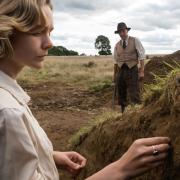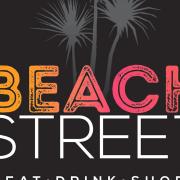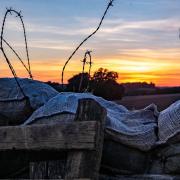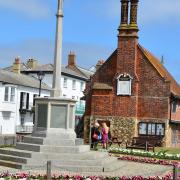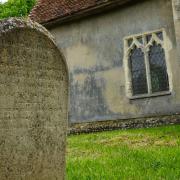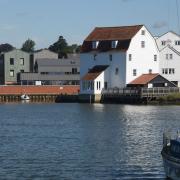This month, why Dunwich is our very own Atlantis
This month, why Dunwich is our very own Atlantis
In a way, Dunwich is probably the closest thing that Suffolk possesses to an Atlantis. Somewhere out there on the coast, under that heaving grey duvet of the North Sea, south of Southwold, lies old Dunwich, once the ancient capital of East Anglia and an important medieval port. Legends from my own boyhood, described how on certain nights, the bells of the sunken church could be heard ringing under the sea. Dunwich, though, had more than one church. There were eight which they know about and it’s been suggested that during its peak as a port, the town may have had anything up to 18 religious houses. Then, in 1286, a severe storm swept in, washing much of the place away. Despite attempts to rebuild its damaged harbour, over the next few centuries, the sea consumed most of the rest of the town too. In Dunwich’s low crumbling cliffs, off-white flecks will sometimes be found. They are said to be the crumbled bone fragments of the town’s medieval citizens, buried in a churchyard which once lay on the former outskirts of the town, a mile and a half inland.Dunwich today is much visited and yet still retains a haunted charm of its own. In the hazy dog days of August, when the inland heat and humidity can become oppressive, the endless shingle and sand of its beach is a delicious place to be. Even when it’s crowded, because the beach is devoid – apart from its tea-rooms – of any commercial amenities or amusements, it seems relaxed and unflustered. Here are no droning Jetskis or power-boats, only the timeless echo of children, gulls and of course, the sea itself. On the right sort of day, you might just as well be on an Edwardian beach, so unchanged and unchanging does it all seem. It’s also interesting, however, to see Dunwich out of season, say, in early spring. Wrap up well though. What the tourist brochures never tell you, is that from winter to spring, sometimes, right through till mid-May, the north-east winds scythe over this coast for days at a time, on a needs-to-blow basis,if you like. East Anglians will tell you, almost with a grim sort of pride, that such winds come ‘straight from Siberia’. Even in the strengthening sharp sunlight of spring, the wind has a capacity to sting your hands, chap your face and chill you to the marrow. That’s when you’ll notice how solid the pretty local cottages seem to be. And that’s also when you begin to understand how, over time, the relentless North Sea licked its way through a couple of country miles of historic Suffolk. Apart from the estimable Ship Inn and the beachside Flora Tea Rooms, Dunwich nowadays consists of one street, a few cottages and a small museum. There’s also a ruined Franciscan priory located perilously close to the ever-crumbling cliffs. By any other terms the place would be classed as a village and yet, because of what it once was, it retains its town status in name. Wander around on a freezing day, when the only hardy souls not tucked away in the bosom of The Ship Inn are a few well-clad birdwatchers. Only now will you start to get another aspect of this strangely soulful place. On summer weekends when the Dunwich lanes are busy with cars, the village of Westleton, two miles down the heathland road, can provide sanctuary. Braces of good traveller reviews will tell you about the Westleton’s Crown Hotel. I, however, have never got past the White Horse, a B&B pub tucked away behind Westleton Green, next to a classic village duckpond. Over the years, I’ve eaten there, drunk there and once or twice, stayed there.They do the best ham, egg and chips in Suffolk and the service is friendly. On the slopes of Westleton Green is a large, medieval-looking shed. For years, I’d supposed that it was where they kept the stuff for Westleton’s annual barrel-rolling competition. When, finally, I asked someone what its original use was, I was told that it had been the village’s coffin shed. Ah, but what was it used for now? I asked. No idea, they said, but last thing they’d heard was that Doc Cox , the musician and former That’s Life presenter had bought it. Westleton’s best-kept secret, however, is its extraordinary second-hand bookshop, located in an old chapel on the main road, near the Green. For 30-odd years I’ve popped in there only sporadically. It never changes. When you walk into the Chapel Bookshop, the first thing you’ll notice is the sweet, dusty smell of old books. There are more books here than you can shake a stick at and yet no one seems to be in attendance. That’s when you’ll see an old tin with a stick next to it. There’s a hand-written notice which requests that you bang the tin with the stick if you require attention. Now Bob will materialise from a back room, silently – like Mr Tumnus from behind a snow-laded fir tree – and he will ask you if you’d like tea or coffee. Robert Jackson, the Chapel Bookshop’s softly-spoken, eccentric owner, originally wanted to run an art gallery. He fell into running a bookshop, almost by default, he claims. There are old sofas for you to sit upon. The shop seems unguarded, although, there used to be a sign which warned that if you nicked a book, an alarm would go off in your head. The book stock can be pleasingly esoteric. There are volumes of the Victorian mystic, Madam Blavatsky’s work here, for instance. There’s also a small stock of vintage vinyl records wherein I found, among other things, a first pressing of The Beatles A Hard Day’s Night. The Westleton bookshop, Dunwich beach and The White Horse pub; no tour operator is ever likely to sell you this package. I would recommend it, though.



